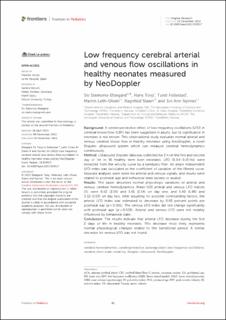| dc.contributor.author | Ødegård, Siv Steinsmo | |
| dc.contributor.author | Torp, Hans | |
| dc.contributor.author | Follestad, Turid | |
| dc.contributor.author | Leth-Olsen, Martin | |
| dc.contributor.author | Støen, Ragnhild | |
| dc.contributor.author | Nyrnes, Siri Ann | |
| dc.date.accessioned | 2023-01-25T10:33:29Z | |
| dc.date.available | 2023-01-25T10:33:29Z | |
| dc.date.created | 2022-12-03T21:46:17Z | |
| dc.date.issued | 2022 | |
| dc.identifier.issn | 2296-2360 | |
| dc.identifier.uri | https://hdl.handle.net/11250/3046190 | |
| dc.description.abstract | Background: A cerebroprotective effect of low frequency oscillations (LFO) in cerebral blood flow (CBF) has been suggested in adults, but its significance in neonates is not known. This observational study evaluates normal arterial and venous cerebral blood flow in healthy neonates using NeoDoppler, a novel Doppler ultrasound system which can measure cerebral hemodynamics continuously.
Method: Ultrasound Doppler data was collected for 2 h on the first and second day of life in 36 healthy term born neonates. LFO (0.04–0.15 Hz) were extracted from the velocity curve by a bandpass filter. An angle independent LFO index was calculated as the coefficient of variation of the filtered curve. Separate analyses were done for arterial and venous signals, and results were related to postnatal age and behavioral state (asleep or awake).
Results: The paper describes normal physiologic variations of arterial and venous cerebral hemodynamics. Mean (SD) arterial and venous LFO indices (%) were 6.52 (2.55) and 3.91 (2.54) on day one, and 5.60 (1.86) and 3.32 (2.03) on day two. After adjusting for possible confounding factors, the arterial LFO index was estimated to decrease by 0.92 percent points per postnatal day (p < 0.001). The venous LFO index did not change significantly with postnatal age (p = 0.539). Arterial and venous LFO were not notably influenced by behavioral state.
Conclusion: The results indicate that arterial LFO decrease during the first 2 days of life in healthy neonates. This decrease most likely represents normal physiological changes related to the transitional period. A similar decrease for venous LFO was not found. | en_US |
| dc.language.iso | eng | en_US |
| dc.publisher | Frontiers Media | en_US |
| dc.relation.uri | https://www.frontiersin.org/articles/10.3389/fped.2022.929117/full | |
| dc.rights | Navngivelse 4.0 Internasjonal | * |
| dc.rights.uri | http://creativecommons.org/licenses/by/4.0/deed.no | * |
| dc.title | Low frequency cerebral arterial and venous flow oscillations in healthy neonates measured by NeoDoppler | en_US |
| dc.title.alternative | Low frequency cerebral arterial and venous flow oscillations in healthy neonates measured by NeoDoppler | en_US |
| dc.type | Peer reviewed | en_US |
| dc.type | Journal article | en_US |
| dc.description.version | publishedVersion | en_US |
| dc.source.volume | 10 | en_US |
| dc.source.journal | Frontiers in pediatrics | en_US |
| dc.identifier.doi | 10.3389/fped.2022.929117 | |
| dc.identifier.cristin | 2088197 | |
| dc.relation.project | Norges forskningsråd: 322479 | en_US |
| cristin.ispublished | true | |
| cristin.fulltext | original | |
| cristin.qualitycode | 1 | |

